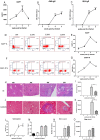Blocking BAFF Alleviates Hepatic Fibrosis in Schistosoma japonicum-Infected Mice
- PMID: 37375483
- PMCID: PMC10302281
- DOI: 10.3390/pathogens12060793
Blocking BAFF Alleviates Hepatic Fibrosis in Schistosoma japonicum-Infected Mice
Abstract
Schistosomiasis is an immunopathogenic disease characterized by egg granuloma and fibrosis. The hepatic fibrosis of schistosomiasis is caused by the coordinated action of local immune cells, liver-resident cells and related cytokines around the eggs of the liver. B-cell-activating factor (BAFF), expressed in many cells, is an essential factor for promoting the survival, differentiation, and maturation of cells. The overexpression of BAFF is closely related to many autoimmune diseases and fibrosis, but has not been reported to play a role in liver fibrosis caused by schistosomiasis. In the study, we found that, during Schistosoma japonicum (S. japonicum) infection in mice, the level of BAFF and its receptor BAFF-R progressively increased, then decreased with the extension of infection time, which was consistent with the progression of hepatic granuloma and fibrosis. Anti-BAFF treatment attenuated the histopathological damage in the liver of infected mice. The average areas of individual granulomas and liver fibrosis in anti-BAFF treatment mice were significantly lower than those in control mice, respectively. Anti-BAFF treatment increased the IL-10, decreased IL-4, IL-6, IL-17A, TGF-β, and downregulated the antibody level against S. japonicum antigens. These results suggested that BAFF acts a strong player in the immunopathology of schistosomiasis. Anti-BAFF treatment may influence Th2 and Th17 responses, and reduce the inflammatory reaction and fibrosis of schistosomiasis liver egg granuloma. It is suggested that BAFF might be a prospective target for the development of new methods to treat schistosomiasis liver fibrosis.
Keywords: B-cell-activating factor; Schistosoma japonicum; anti-BAFF treatment; apoptosis; liver fibrosis.
Conflict of interest statement
The authors declare no conflict of interest.
Figures



Similar articles
-
Deficiency of PKCλ/ι alleviates the liver pathologic impairment of Schistosoma japonicum infection by thwarting Th2 response.Parasit Vectors. 2022 May 3;15(1):154. doi: 10.1186/s13071-022-05283-x. Parasit Vectors. 2022. PMID: 35505421 Free PMC article.
-
IL-37 alleviates liver granuloma caused by Schistosoma japonicum infection by inducing alternative macrophage activation.Parasit Vectors. 2022 Aug 24;15(1):300. doi: 10.1186/s13071-022-05420-6. Parasit Vectors. 2022. PMID: 36002836 Free PMC article.
-
Schistosoma japonicum scFv-IL18 fusion DNA ameliorates hepatic fibrosis in schistosomiasis-infected mice via improving local concentration of IL-18 in liver.Exp Parasitol. 2013 Aug;134(4):447-54. doi: 10.1016/j.exppara.2013.05.002. Epub 2013 May 14. Exp Parasitol. 2013. PMID: 23684910
-
T Lymphocyte-Mediated Liver Immunopathology of Schistosomiasis.Front Immunol. 2020 Feb 18;11:61. doi: 10.3389/fimmu.2020.00061. eCollection 2020. Front Immunol. 2020. PMID: 32132991 Free PMC article. Review.
-
Cellular and chemokine-mediated regulation in schistosome-induced hepatic pathology.Trends Parasitol. 2014 Mar;30(3):141-50. doi: 10.1016/j.pt.2013.12.009. Epub 2014 Jan 13. Trends Parasitol. 2014. PMID: 24433721 Review.
Cited by
-
Dysregulated Glucuronidation of Bilirubin Exacerbates Liver Inflammation and Fibrosis in Schistosomiasis Japonica through the NF-κB Signaling Pathway.Pathogens. 2024 Mar 28;13(4):287. doi: 10.3390/pathogens13040287. Pathogens. 2024. PMID: 38668242 Free PMC article.
References
-
- Wang Y.-J., Xu Y.-X., Hu Y., Shen Y.-J., Li P., Zhou H.-J., Cao J.-P. Destructive effect of eggs of Schistosoma japonicum on spleens in C57BL/6 mice. Zhongguo Xue Xi Chong Bing Fang Zhi Za Zhi. 2011;23:285–287. - PubMed
-
- Song L.-J., Yin X.-R., Mu S.-S., Li J.-H., Gao H., Zhang Y., Dong P.-P., Mei C.-J., Hua Z.-C. The Differential and Dynamic Progression of Hepatic Inflammation and Immune Responses During Liver Fibrosis Induced by Schistosoma japonicum or Carbon Tetrachloride in Mice. Front. Immunol. 2020;11:570524. doi: 10.3389/fimmu.2020.570524. - DOI - PMC - PubMed
Grants and funding
- Q202001, Q201937 & M202202/Youth and General Foundation of Wuxi Municipal Health Commission of Jiangsu Province
- 81802035/National Natural Science Foundation of China
- N20202040/Wu-xi Science and Technology Planning Project (Medical and Public Health Research and development Project)
- JHPU201834 & JUPH-RC-202005/Pro-ject of Public Health Research Center of Jiangnan University
- TC2021A033/Open sharing of independent research projects for large-scale scientific instruments in Jiangsu Province
LinkOut - more resources
Full Text Sources

